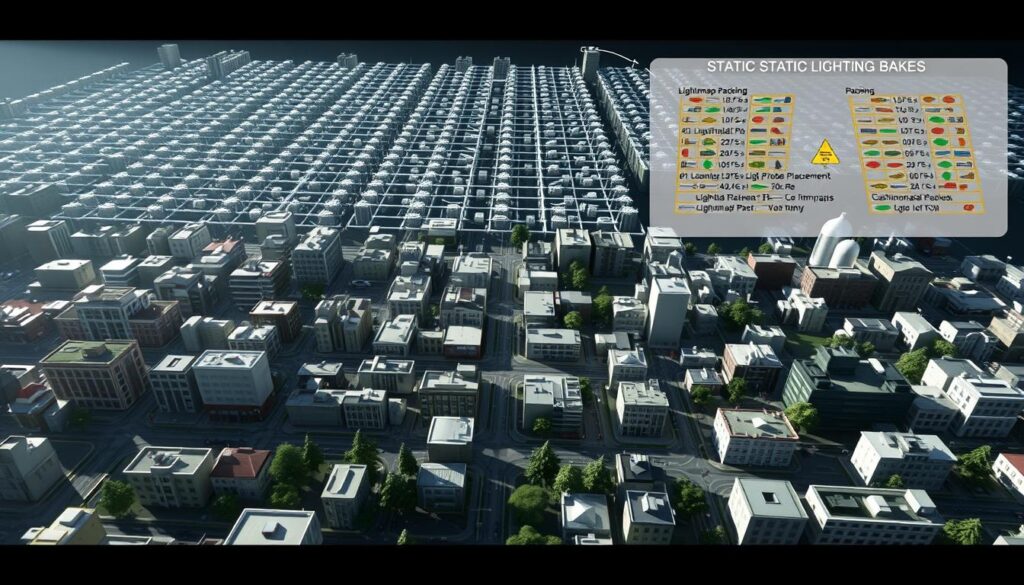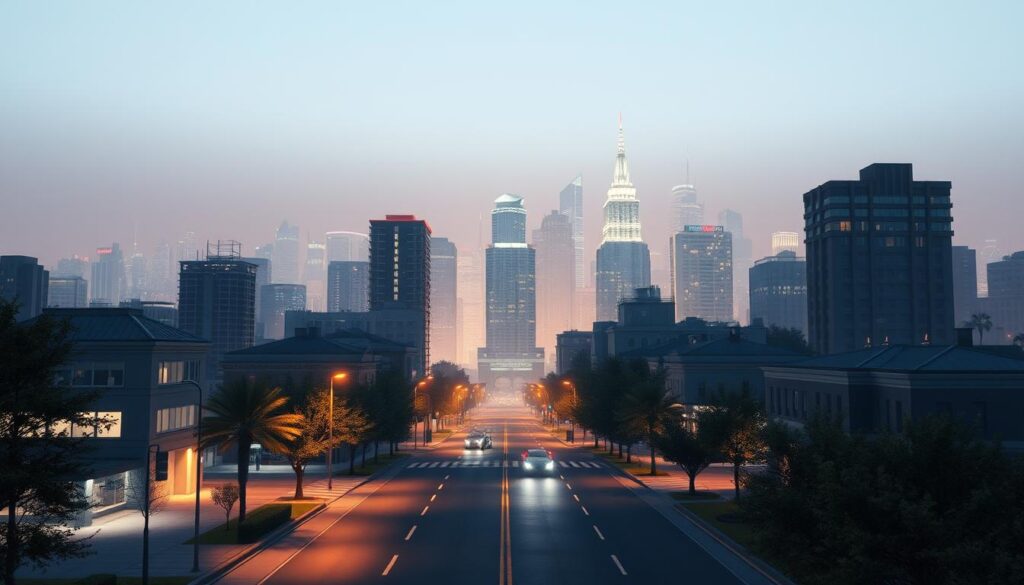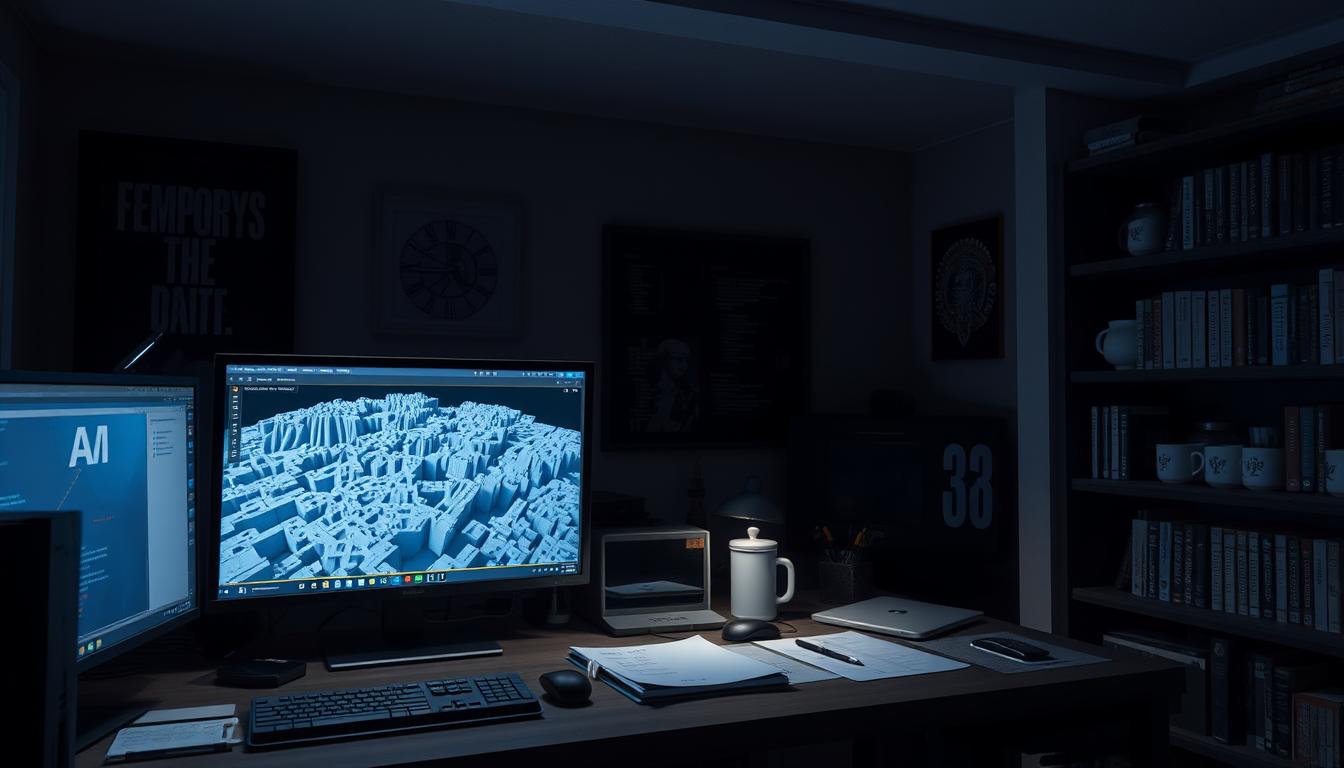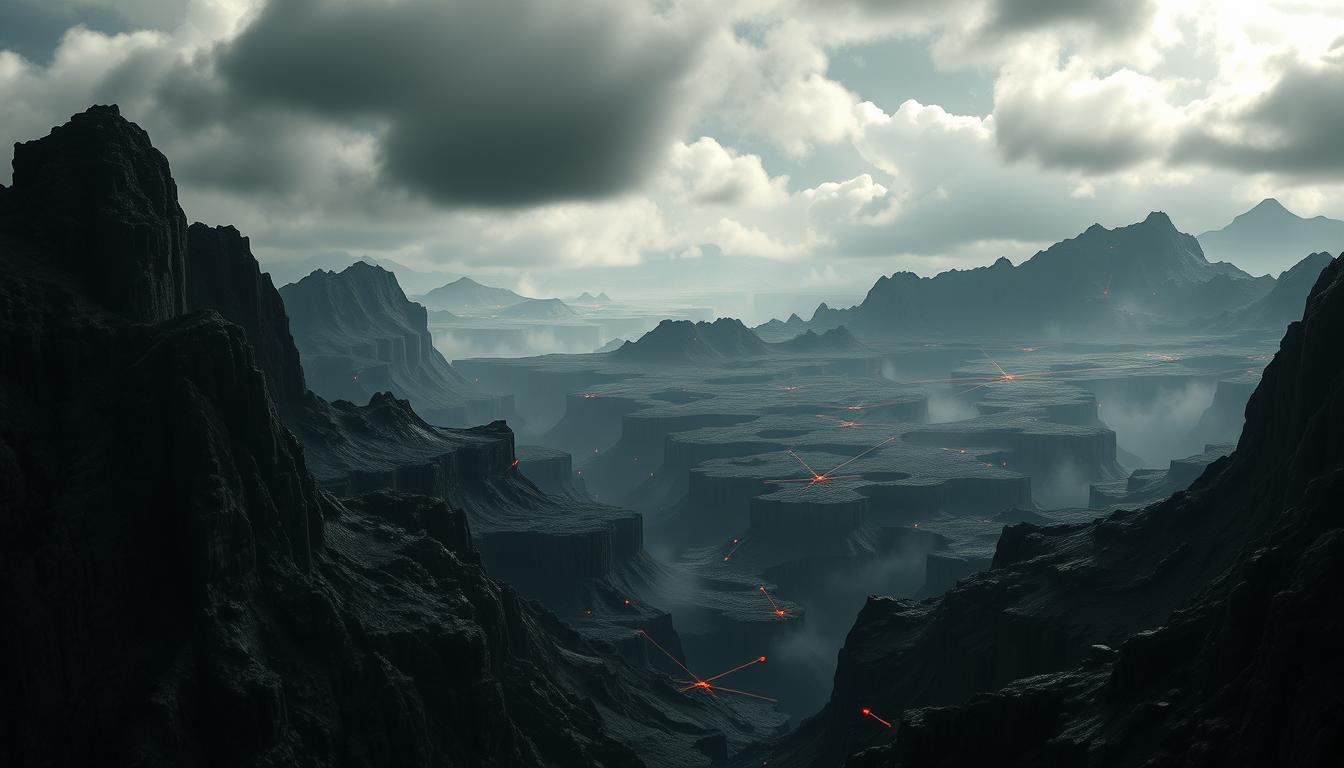Ever wondered how some mobile games look so good without slowing down? It’s all about optimized static lighting strategies. These are key for making procedural rendering work well on mobiles. We’ll explore how these techniques improve visuals and keep games running smoothly.
By using these strategies, developers can make cities in games look real and engaging. This makes the game world feel more alive and fun to explore.
Introduction to Static Lighting Bake Strategies
Static lighting bake strategies are key for efficient rendering of procedural cities. They involve precomputing lighting data to boost performance, especially on mobiles. This method reduces the load during runtime by baking lighting into textures.
In procedural cities, complex geometry and dynamic elements are common. Static lighting is a practical solution to keep visuals sharp without using too many resources. It makes intricate designs possible, improving the gaming experience on mobiles.
Using static lighting strategies makes rendering smoother and enhances the player’s experience. As mobile optimization grows, these techniques are crucial for developers. They help create beautiful, efficient apps.

Importance of Optimized Static Lighting for Procedural Rendering
Optimized static lighting is key in procedural rendering, especially for mobile devices. It boosts performance and makes visuals pop in big procedural cities. Using smart lighting techniques makes games run faster, keeping the experience smooth on all devices.
Enhancing Performance on Mobile Devices
Mobiles have limited power and memory. Optimized static lighting helps by cutting down on work for the device. It uses pre-made light info, so games don’t have to do math on the fly. This means better performance and faster loading times, making users happier.
Improving Visual Quality in Procedural Cities
Lighting makes procedural cities look real and inviting. Optimized static lighting keeps things looking good without using too much power. With smart lightmaps, developers can show off textures and colors, pulling players into the game world. This makes the game more engaging and keeps players coming back.

Understanding Baked vs. Real-time Lighting
The choice between baked lighting and real-time lighting greatly affects how procedural environments look and perform in Unity. Baked lighting uses lightmaps made before the game starts. These lightmaps hold static light information. This method helps keep the game smooth, especially on mobiles where resources are tight.
On the other hand, real-time lighting updates shadows and light for every frame. It’s more flexible, working well with moving objects and changing scenes. But, it uses more resources, which can slow down mobile games.
The following shows how these lighting methods compare:
| Feature | Baked Lighting | Real-time Lighting |
|---|---|---|
| CPU/GPU Usage | Low | High |
| Performance | Better for Mobile | Variable |
| Flexibility | Limited to Static Elements | Dynamic Scenes |
| Visual Quality | Consistent and High | Varies Depending on Hardware |
Knowing the differences helps developers choose the right lighting method. Baked lighting offers high performance and detailed lighting without sacrificing the game’s feel.
Best Practices for Baking Lighting in Unity
Effective baking lighting in Unity makes procedurally generated cities run better, especially on mobile. It’s key to mark static objects correctly and pick the right light types. Knowing these Unity best practices helps get high-quality lightmaps.
Setting Up Static Objects
First, mark objects as static before baking lighting. This tells Unity they won’t move, improving lighting calculations. Here’s how to set up static objects:
- Select the object in the Scene view.
- In the Inspector window, check the “Static” checkbox.
- Make sure colliders and renderers are set up right for lightmap generation.
Choosing the Right Light Types
The type of light you use greatly affects your scene’s look. Each light type in Unity has its own use and impact on performance. Knowing these options helps use baking lighting strategies well. Here’s a look at common light types:
| Light Type | Description | Best Use Cases |
|---|---|---|
| Directional Light | Simulates sunlight, casting parallel shadows. | Outdoor scenes or large open environments. |
| Point Light | Emits light in all directions from a single point. | Interior lighting, lamps, or small fixtures. |
| Spotlight | Illuminates a specific area, creating focused beams. | Theatrical settings or dynamic lighting effects. |
| Area Light | Cast soft shadows over a defined rectangular area. | Large spaces requiring soft, diffuse lighting. |
Using the right mix of static objects and light types leads to better lightmaps. Following these best practices boosts both look and performance in Unity’s procedurally generated cities.
Implementation of Lightmap Settings
Getting lightmap settings right in Unity is key for great lighting and good performance. It starts with setting the Unity lightmap resolution. This affects how detailed the lighting looks in your scenes. A high resolution means better lightmaps but can slow down mobile devices.
Finding the perfect balance is important for making procedural cities look great.
Configure Lightmap Resolution
When choosing the Unity lightmap resolution, think about your scene’s size and detail. A good range is 40 to 70 texels per unit. This captures detailed lighting without making the lightmap too big.
Also, consider the texture size. Bigger lightmaps can look better but use more memory. Try different sizes to find the best balance for your project.
Adjusting Bounces and Samples
Changing the number of bounces in lightmap settings can make interior lighting better. More bounces mean softer shadows and more realistic scenes. But, it might need more samples to keep performance up.
Sample counts between 20 to 50 usually work well. But, you might need to adjust these to get the lighting just right for your project. Finding the right mix of bounces and samples is crucial for procedural city lighting.
Using Bakery for Efficient Light Baking
Bakery light baking is a powerful tool for Unity. It makes baking lighting in complex scenes easier. It also helps improve lighting quality without losing performance.
Before you start, check if your system can run Bakery. It works well with Unity tools, helping developers improve their work. Once installed, you can adjust lightmap settings easily, unlike traditional methods.
Bakery stands out because you can tweak lightmaps in Unity. This lets developers create more realistic lighting. It’s especially useful for procedural cities, where lighting affects the player’s experience.
If you’re struggling with old baking methods, Bakery has solutions. It helps achieve better lighting and more engaging environments. Using Bakery can change how developers handle lighting in Unity, making it more efficient and visually stunning.
Leveraging Level of Detail (LOD) Techniques
In mobile game development, managing resources well is key. Using Level of Detail (LOD) techniques can boost performance and keep visuals sharp. By changing model complexity based on camera distance, developers can make rendering more efficient.
LOD makes switching between detailed and simple meshes smooth. This means only needed geometry is processed, boosting frame rates. It’s vital in mobile games where resources are scarce.
Reducing Geometry Complexity
LOD techniques involve making different versions of a model at various detail levels. As a player moves away, the engine switches to a simpler version. This is crucial for better performance on mobiles.
- Improved Performance: Fewer polygons mean faster rendering.
- Resource Efficiency: It lightens the load on the mobile GPU.
- Dynamic Adjustments: It quickly adapts to camera distance, keeping visuals clear.
Advanced Lighting Techniques for Procedural Cities
When making procedural environments, using advanced lighting makes them look better and run smoother. Light probes are key here. They capture indirect light, making scenes look more real, especially with moving objects in static scenes.
Utilizing Light Probes
Light probes help add dynamic lighting without slowing down the game. By placing them smartly in a procedural city, developers can make sure moving things like characters and cars look right. This makes the game feel more real and engaging.
Using light probes with static lighting is a smart mix. It keeps the game running well while adding lots of visual details. Knowing how to use light probes well helps developers make environments that feel alive and detailed.
Optimizing Scene Setup for Mobile Performance
To improve mobile performance, it’s key to make scene setup more efficient. Mobiles have limited power, so managing draw calls is crucial. This means fewer objects in each frame for better gameplay.
Managing Draw Calls Effectively
Lowering draw calls is vital for smoother mobile apps. Use static batching for stationary objects. This method groups them into one call, saving resources.
Dynamic batching helps with moving parts. It ensures they also get the draw call reduction. Also, use atlas textures to combine multiple textures into one. This cuts down on material swaps, reducing draw calls.
Employing Culling Techniques
Using occlusion and frustum culling boosts scene efficiency. Occlusion culling hides objects not seen by the camera. Frustum culling skips objects outside the camera’s view.
These methods lighten the load on mobiles. They help improve frame rates, making games smoother.
Shader and Texture Optimization for Mobile Devices
Shader optimization is key to better mobile rendering. Mobiles have less power and memory than desktops. So, using simpler shaders can make a big difference. Developers should aim for lightweight shaders that look good and run fast.
Texture optimization is also vital. The right texture formats can save memory without losing quality. Compressed formats help reduce memory use, making procedural cities look great and run smoothly on mobiles.
Mipmapping is a smart texture optimization trick. It uses different texture sizes based on camera distance. This boosts performance and looks. Also, optimizing texture atlases cuts down on texture swaps, making complex scenes smoother.
Using shader and texture optimizations together makes procedural city rendering on mobiles smooth. These steps improve gameplay, making mobile experiences better and more fun. Players get the visuals they want without lag.
Testing and Fine-tuning Lightmaps for Procedural Environments
Testing lightmaps is key to quality in procedural environments. To get the best results, you need to fine-tune settings that affect lighting. This part will show you how to spot common problems and fix them, making your visuals better.
Identifying and Correcting Artifacts
When you test lightmaps, you might see banding or low-resolution spots. These issues come from settings not being right during light baking. To fix these, you need a solid plan for testing and fixing.
- Check lightmap quality by looking for shading or color problems.
- Use game engine tools to see lightmap data, helping you find issues.
- Change lightmap resolution based on your scene’s needs to avoid low-res issues.
- Try different settings in several tests to find the best one.
By following these steps, you can lower the chance of visual problems. Regular checks and tweaks will make your lighting better. This will make your procedural city landscapes more real and engaging.
Common Challenges in Static Lighting Bake Strategies
Developers face many challenges when using static lighting bake strategies. One big problem is getting lightmaps to match 3D geometry perfectly. This can cause uneven lighting, making procedural environments look less realistic.
Another issue is dealing with too much or too little light in certain areas. Finding the right balance is hard, especially in complex terrain. If not done right, it can make scenes look flat or too bright, ruining the immersive feel.
Managing lightmap size is also crucial. Big lightmaps can slow down mobile devices. Developers need to find the right balance between size and detail to keep things running smoothly.
Conclusion
Optimizing static lighting is key for top-notch rendering in procedural cities, especially on mobile. The methods talked about in this article show how to balance speed and quality. Using light baking in Unity and Bakery can greatly improve projects.
Also, using Level of Detail (LOD) and light probes helps complex scenes look great without slowing down. As more people want mobile games and apps, knowing how to optimize lighting is crucial. It helps creators make their ideas shine on mobile devices.
Getting the hang of static lighting in procedural environments means better details and smoother action. Developers who use these tips can create amazing, engaging experiences. These experiences will impress users on all sorts of mobile devices.
FAQ
What are static lighting bake strategies and why are they important for mobile rendering?
Static lighting bake strategies are about precomputing lighting data. This makes rendering more efficient, especially for mobile games. It helps reduce the load on the GPU, making games smoother and look better.
How do baked and real-time lighting differ in Unity?
Baked lighting in Unity uses lightmaps with precomputed data. It’s easier on the CPU/GPU. Real-time lighting, on the other hand, updates lighting and shadows for moving objects. This can be more demanding, especially on mobiles.
What best practices should I follow when baking lighting in Unity?
Make sure to mark objects as static for baking. Choose light types that save resources. Find a good balance in your baking settings. This will help make your lightmaps efficient and improve rendering in your games.
How can I optimize lightmap settings for my mobile game?
Adjust the lightmap resolution to find a balance between quality and performance. Change light bounces and sample counts. More bounces help with indoor lighting, while the right sample count makes lightmaps better.
What is the Bakery plugin and how does it improve light baking?
The Bakery plugin is a tool for creating lightmaps in complex scenes. It offers advanced features that improve lighting quality. It’s great for detailed designs in mobile games, making visuals even better.
What are Level of Detail (LOD) techniques and how do they help in mobile environments?
LOD techniques use simpler meshes for distant objects. This reduces the GPU’s workload. It helps keep mobile games running smoothly and looking good.
How do light probes enhance procedural lighting in mobile games?
Light probes capture dynamic and indirect lighting. They make sure moving objects look right while still using baked lighting’s performance benefits.
What strategies exist for optimizing scene setup for mobile platforms?
Good scene setup includes managing draw calls and using culling. Techniques like frustum and occlusion culling prevent unnecessary rendering. This boosts performance a lot.
What are some shader and texture optimization techniques for mobile rendering?
Use simpler shaders and choose the right texture formats. This lowers memory use without losing quality. It’s key for smooth rendering on mobiles.
How can I test and fine-tune lightmaps to improve quality?
Check lightmaps for issues like banding or low resolution. Fixing these problems means adjusting settings to improve lightmap quality. This enhances visual fidelity in your games.
What common issues should I be aware of when implementing static lighting bake strategies?
Be aware of problems like poor light alignment and uneven lighting. Also, managing lightmap sizes can be tough. Knowing these issues helps create better visuals in your projects.




